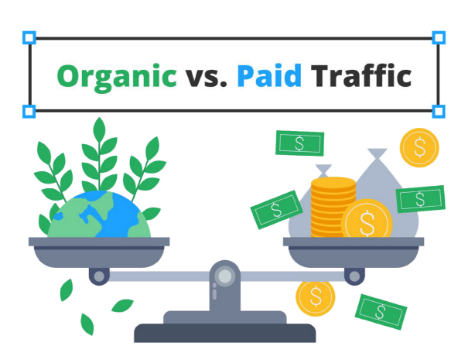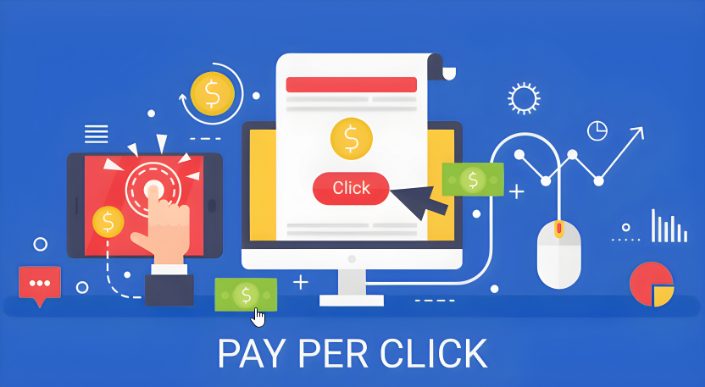Emily specializes in SEO, content marketing, social media strategy, and PPC campaigns. She is particularly skilled at analyzing market trends and adapting strategies to stay ahead of the curve.
Imagine you’re playing a video game, and your character is preparing for a massive battle.
On the one hand, you have a strong sword representing organic traffic, which requires a lot of skill and time to master.
On the other hand, you have a quick and easy solution – a catapult (paid traffic) that can quickly launch you into battle, but with recurring costs for each use.
Your choice of weapon in this marketing battle can significantly impact your budget, results, and long-term success.
Many businesses find themselves at this crossroads, trying to decide between investing time and resources in SEO and content creation to attract organic traffic or opting for the immediate results offered by paid ad campaigns.
The decision isn’t always easy, especially considering the costs involved.
But let’s delve deeper.
Let’s dissect the economic advantages of organic traffic and how it can ultimately provide a higher and more sustained return on investment (ROI).
So, what exactly is organic traffic?
Organic traffic is all about visitors landing on your website naturally through unpaid search results.
Imagine someone typing a query into Google and voilà, your website pops up.
This is organic traffic in action – it’s essentially free and comes without the cost of paid ads.
Now, let’s look at paid traffic.
This is the crowd you draw through paid advertising efforts.
Whether it’s from a pay-per-click (PPC) on Google Adwords, a sponsored post on social media, or a direct mailer, all these visitors count as paid traffic.

While both types of traffic can contribute to your business’s growth, they have different implications for your marketing budget, strategy, and long-term success.
Understanding the nuances of each is key to shaping a robust digital marketing strategy that not only drives traffic but fosters lasting connections with your audience.
Let’s tackle a key point about organic traffic: while it’s often viewed as ‘free,’ the truth is, to truly capitalize on organic traffic, you must first maximize your website’s visibility.
This requires investing in SEO strategies.
Without it, achieving organic traffic can be a difficult task, if not impossible.
SEO is all about helping your website climb higher in search engine results pages, or SERPs.
This journey starts with thorough keyword research – finding the terms that your potential customers are using.
But it’s more than just plugging in keywords; it’s about creating valuable content that resonates with your audience.
Then comes on-page optimization – this is tweaking everything on your site, from meta tags to image alt texts, to make it more search engine friendly.
And don’t forget the technical stuff – ensuring your site is fast, responsive, and accessible.
(There’s more to what happens behind the scenes of SEO, but I’ll keep it short for now.)
So, why do all this? Because when your site ranks higher, it’s not just more visible – it’s also seen as more credible and authoritative.
And in the digital world, especially for clients in the high-trust industry, credibility is gold.
People tend to trust and, more importantly, click on sites that appear higher up in search results.
The result – increased organic traffic.
So, investing in effective SEO methods is vital since it helps you develop a stable, long-lasting foundation for your website.
Sure, it takes time and effort, but without it, there is no groundwork for lasting success.
Let’s break down the cost structure of organic versus paid traffic.
Paid traffic is all about instant visibility at a direct cost.
You pay for each click or impression your ad receives.
This could be through a PPC model like Google Ads or a cost-per-impression (CPM) approach used in many display and social media ads.
The key here is budget dependency.
The more you spend, the more visibility you get.
But just like a prepaid phone, once you stop topping up, the service – or, in this case, the traffic – stops.
This approach is fantastic for quick results and temporary visibility, but your costs can fluctuate depending on factors like competition, keyword demand, and ad quality.
Now, let’s switch gears to organic traffic.
This is more like investing in a solar panel system for your home.
There’s an initial setup cost involved in optimizing your website for search engines – think content creation, keyword strategy, and technical SEO.
But once it’s up and running, the energy – or traffic – keeps on coming without the ongoing costs of traditional power sources.
It’s a long-term investment, and while it takes time and effort to build up, the sustainable traffic you get can be a game-changer.
Unlike paid traffic, you’re not paying for each visitor who comes to your site.
And your cost doesn’t fluctuate based on how competitive the industry is.
The ongoing maintenance costs are also significantly lower in comparison to the long-term cost of paid ads.
Now, let’s talk about the ROI you can expect from organic traffic.
Spoiler alert: it’s often much higher than what you get from paid traffic.
Here’s why.
Think about organic visitors as guests who’ve intentionally walked into your store.
They’re here because they’re actively searching for something you offer.
They have a specific need or problem, and they’re on your site because they think you might just have the solution they’re looking for.
This isn’t just casual browsing; it’s targeted interest.
This level of intent makes them far more likely to really engage with what you have to say, sign up for your newsletter, or, better yet, make a purchase.
Let’s dive into some interesting stats:
Organic search results rake in about 8.5 times more clicks than paid search results, which usually have a click-through rate (CTR) of around 1.5 times.
Now, why does this matter? This higher CTR isn’t just a number; it reflects a deeper level of user engagement and interest.

A higher engagement often means better conversion rates – that’s more people taking the action you want them to on your website.
To bring this talking point into our world of high-trust industries, here are some additional statistics from the healthcare space.

The average conversion rate for organic search in the healthcare industry is approximately 5%, compared to 3.36% for paid search ads.

In the professional services industry, organic traffic has a 12.3% conversion rate versus 7% for paid search.
The difference is huge.
It means that organic search isn’t just drawing more eyes; it’s drawing the right eyes – people who are more likely to engage and convert.
Now, let’s talk about the lasting impact of SEO and content creation.
Unlike some marketing strategies that offer quick but fleeting results, the effects of solid SEO and engaging content are cumulative – they build upon themselves over time.
As your site starts ranking for more keywords and pulling in more backlinks, your visibility on search engines increases.
This isn’t just a one-time traffic spike; it’s sustained growth, and with it comes a continually increasing ROI.
In the long run, this makes organic traffic not just effective but incredibly cost-efficient.
You’re not just generating traffic; you’re cultivating a steadily growing audience that finds real value in what you offer.
So, investing in organic traffic isn’t just a smart strategy; it’s a long-term investment in the health and success of your digital presence.
Alright, let’s talk about something that every business cares about – getting the best bang for your buck.
When it comes to cost-effectiveness, organic traffic often has the upper hand over paid traffic.
Let me break it down for you.
Investing in SEO and content creation might seem like a hefty cost upfront.
But here’s the kicker – once your content starts ranking well in search results, the CPC becomes almost negligible.
Picture this scenario: you’re running a paid ad campaign, paying around $2 per click.

If 100 people click on your ad, you’re shelling out $200, right?
Now, let’s flip to the organic side.
Suppose you invest that same $200 into creating a killer, SEO-optimized blog post.
Sure, the initial cost is the same, but here’s where it gets interesting: that blog post keeps pulling in traffic long after it’s been published.
There’s no running meter on that blog post.
In contrast, your paid ad? It stops dead in its tracks the moment your budget runs out.
So, while the initial investment in organic SEO may look similar to a paid campaign, their cost-effectiveness and the ROI can be significantly higher.
It’s a classic case of slow and steady winning the race.
It’s tempting to get dazzled by the instant gratification of paid ads.
But let’s not overlook the economic benefits of organic traffic.
Choosing the right strategy in this marketing battlefield is crucial.
Going organic might seem daunting at first – it takes time, effort, and patience.
But trust me, the long-term benefits are substantial.
Embrace the organic approach, and you’ll see your business not just grow but truly flourish in the digital landscape.